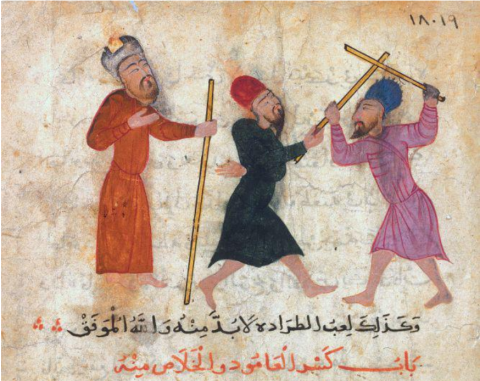"Your friend contests whomever you contest" | "صديقك من يعادي من تعادي"
Introduction to the Text
“Your friend contests whomever you contest” comes from the collected works ascribed to Muḥammad ibn Idrīs al-Shāfiʿī, better known as al-Imām al-Shāfiʿī (d. 820). The great belletrist ʿAbd al-Mālik al-Thaʿālibī (d. 1038) marshals these verses in blame of friendship in his famous anthology, Yāwāqīt al-Mawāqīt fī Madḥ Kull Shayʾ wa-Dhammihi wa-Tazyīnihi wa-Tahjīnihi (Rubies of the Ages in Praise, Blame, Adornment, and Debasement of Everything), alternatively titled al-Laṭāʾif wa-al-Ẓarāʾif (The Subtle and Eloquent [Expressions]). The anthology bespeaks an age's incessant knack for wit. With the right evidence, eloquence, and sense of humor, authors absurdly uglified the beautiful and beautified the ugly.
We have no extant manuscripts from his period that include al-Shāfiʿī's poetic works, which appeared in various anthologies since the Middle Ages. Only relatively recently, at the turn of the twentieth century, was the poetry ascribed to him published in a single dīwān, or poetry collection. These poems were penned by different hands at different points in history. In the preface to his second edition of the Dīwān, Dr. Mujāhid Bahjat notes that the majority of poems ascribed to al-Shāfiʿī may be ascribed to other poets or are otherwise unconfirmed as his own; he traces only twelve directly to him, whereas a given edition may include over 160 poems and poetic fragments (Bahjat 3-4, 19-20).
Although primarily recognized as the namesake to one of the four main jurisprudential schools (or madhāhib, sg. madh'hab) in Sunni Islam, al-Imām al-Shāfiʿī equally distinguished himself as a master of language and adab (belles-lettres). Growing up, this descendant of the prophetic line of the Banū Hāshim tribe lived among the Hudhayl—a clan known for the purity of their Arabic—in order to immerse himself in the study of the language. This training made his reputation as a poet and poetic critic. Years later, in Baghdad, the famed philologist and grammarian al-Aṣmaʿī (d. 828) would visit al-Shāfiʿī to take Hudhalī poetry from him. As did all eminent scholars who sought him out (there were many), he marveled at al-Shāfiʿī's double command of language and poetry.
al-Imām al-Shāfiʿī was born in Gaza in 767. With the death of his father, he and his mother moved to Mecca two years later. His pursuit of knowledge (or ṭalab al-ʿilm) brought him at a young age to Medina, where he studied ḥadīth (prophetic narrations) and fiqh (Islamic law) under al-Imām Mālik ibn Anas until the latter’s death in 795. He then accepted a post in Yemen as governor of Najran, although a revolt in 803 prematurely ended his political career when it led to his arrest and summoning to the court of the Abbasid caliph Hārūn al-Rashīd (d.809) in al-Raqqah, a city in Syria. There, he would meet the jurist Muḥammad al-Shaybānī (d.805), who helped secure his acquittal. Under al-Imām al-Shaybānī’s tutelage, al-Shāfiʿī relocated to Baghdad. (Among al-Shāfiʿī’s most important students there was al-Imām Aḥmad ibn Ḥanbal (d.855)). al-Shāfiʿī would make one more major move in 814 for Egypt, where he continued to study and teach a variety of subjects, primarily jurisprudence, until his death in 820 at the age of 54.
The verses ascribed to al-Shāfiʿī probably reflect a lifetime’s worth of occasional compositions and pronouncements, and certainly reflect their author’s erudition, fine manners, and familiarity with classical meters. Precise and brief, the poetry nevertheless employs a range of sophisticated rhetorical strategies, from ṭibāq (contrariety) to bayān (eloquence), to jinās (paronomasia), to additional instances of badīʿ (ingenuity)—stylistically unique tropes and schemes (Bahjat 29-37, 42-43). Thematically, the poems touch on the matters of wisdom literature, including personal comportment, friendship, the pursuit of knowledge, and the cultivation of virtues.
Further Reading
Bahjat, Mujāhid M. “Muqaddimat al-Ṭabʿah al-Thāniyah” (“Preface to the Second Edition”). Dīwān al-Shāfiʿī: al-Imām al-Faqīh Abū ʿAbd Allāh Muḥammad ibn Idrīs al-Shāfiʿī, edited by Mujāhid Muṣṭafā Bahjat, Dār al-Qalam, 1999.
Chaumont, E. “al-S̲h̲āfiʿī”, in: Encyclopaedia of Islam, Second Edition, edited by P. Bearman, Th. Bianquis, C.E. Bosworth, E. van Donzel, W.P. Heinrichs, 2012. Consulted online on 25 August 2020
van Gelder, G. “Beautifying the Ugly and Uglifying the Beautiful: The Paradox in Classical Arabic Literature,” Journal of Semitic Studies, vol. 48, issue 2, Autumn 2003, pp. 321–351.
Credits
Transcriped from al-Shāfiʿī, M. 1999. Dīwān al-Shāfiʿī: al-Imām al-Faqīh Abū ʿAbd Allāh Muḥammad ibn Idrīs al-Shāfiʿī, ed. Mujāhid Muṣṭafā Bahjat. Dimashq: Dār al-Qalam, page 97.Translation by Sherif AbdelkarimEncoded in TEI P5 XML by Danny SmithSuggested citation: Muḥammad ibn Idrīs al-Shāfiʿī. ""Your friend contests whomever you contest"." Trans. Sherif Abdelkarim. Global Medieval Sourcebook. http://sourcebook.stanford.edu/text/your-friend-contests-whomever-you-co.... Retrieved on April 19, 2024.

